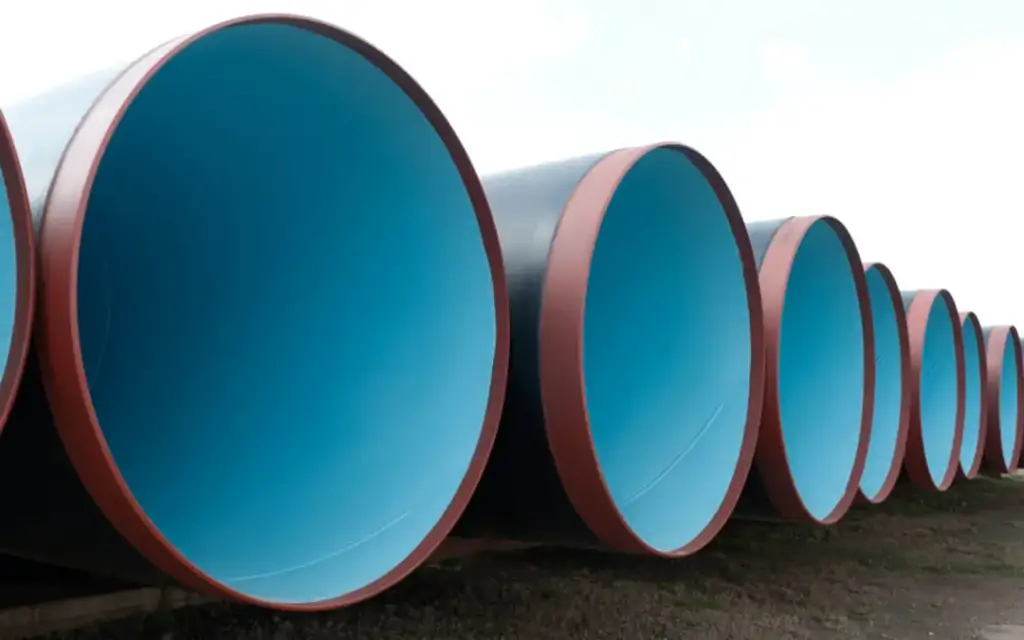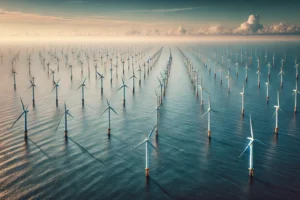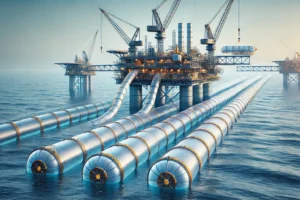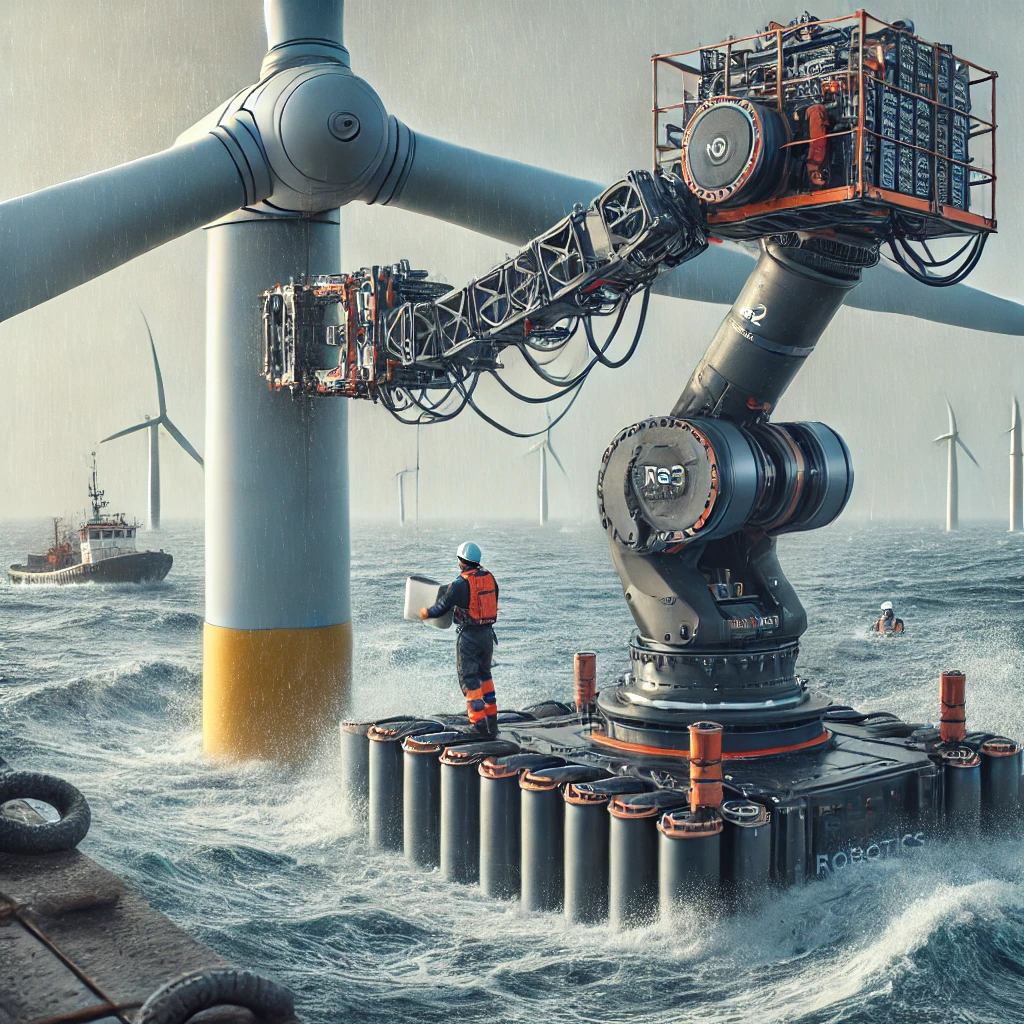The process which involves applying a layer of epoxy resin covering to the interior surfaces of pipes, tanks, and containers is known as epoxy pipe coating. This layer protects against corrosion and chemical damage while also improving fluid flow. Surface preparation is followed by the application of epoxy resin by spray or brush techniques. The final coating is smooth, robust, and resistant to chemicals and abrasion after curing. It may be applied to a variety of pipe materials and is used in industries such as oil and gas, water treatment, and manufacturing. While it has benefits such as increased pipe lifespan and lower maintenance, proper surface preparation and professional application are required.
The oil and gas sector, as well as water treatment plants and other industrial contexts, frequently use epoxy pipe coating. It is also used in home plumbing to increase pipe longevity and performance.
Types of Epoxy Pipe Coatings
There are various types of epoxy pipe coatings available, each designed to meet specific requirements and conditions. Here are some common types:
- Solvent-free epoxy coatings: These coatings are formulated without solvents and are often preferred for applications involving potable water systems. Their low toxicity makes them suitable for environments where minimizing health risks is a priority.
- Solvent-based epoxy coatings: These coatings contain solvents and offer faster curing times compared to solvent-free options. They are used in situations where a quicker turnaround or rapid installation is required.
- Fusion-bonded epoxy coatings: These coatings are applied electrostatically to the pipe surface and then melted to create a sturdy bond. They provide excellent corrosion resistance and are commonly used for both buried and above-ground pipelines.
- Novolac epoxy coatings: These are coatings which have been formulated to offer enhanced chemical resistance. They are particularly suitable for applications where pipes will be exposed to aggressive or harsh chemical environments.
- High-temperature epoxy coatings: High temperature coatings are specifically designed to withstand elevated temperatures. They are applied in situations where the pipes will be exposed to extreme heat, such as in high-temperature industrial processes or exhaust systems.
The choice of epoxy coating depends on the specific application, the operating conditions, and the desired properties of the coated pipes. Factors such as corrosion resistance, chemical resistance, curing time, and temperature tolerance play a significant role in selecting the appropriate epoxy coating.
Applications of Epoxy Coatings
Epoxy pipe coatings find extensive applications across various industries, serving crucial purposes:
- Oil and gas industry: Epoxy coatings safeguard pipelines from corrosion and chemical damage, ensuring the efficient transportation of oil and gas.
- Water and wastewater treatment plants: Epoxy coatings protect pipes and tanks against corrosion and chemical damage caused by the aggressive substances used in the treatment process, maintaining the integrity of the infrastructure.
- Chemical processing industry: Epoxy coatings shield pipes, tanks, and equipment from corrosion and chemical damage induced by harsh substances utilized in manufacturing, ensuring safety and durability.
- Food and beverage industry: Epoxy coatings preserve the hygiene and integrity of pipes and tanks used in food and beverage production, preventing corrosion and contamination risks.
- Residential plumbing: Epoxy coatings extend the lifespan of residential plumbing pipes, guarding against corrosion and deterioration, thus minimizing the need for frequent repairs.
- Marine industry: Epoxy coatings protect ships, offshore structures, and underwater pipelines from corrosion and damage caused by saltwater and harsh marine environments, ensuring their longevity and structural integrity.
In summary, epoxy pipe coatings offer reliable protection against corrosion, chemical damage, and wear and tear, ensuring the smooth operation and longevity of various systems across industries

Applying Epoxy Pipe Coatings for Maximum Effectiveness
Step-by-Step Application Process of Epoxy Pipe Coatings for Optimal Results:
- Surface preparation: Thoroughly clean the interior surface of the pipe, removing rust, debris, and contaminants that could hinder coating adhesion. This can be achieved through sandblasting or using a wire brush.
- Mixing the epoxy: Follow the manufacturer’s instructions to properly mix the epoxy components, typically the resin and hardener. Ensure thorough and uniform mixing to achieve the desired chemical reaction.
- Application: Apply the epoxy coating using a brush, roller, or spray equipment. Aim for a thin and even layer, avoiding drips and inconsistencies. Pay attention to coating the entire surface evenly.
- Curing: Allow the epoxy coating to cure as per the manufacturer’s instructions. This entails leaving the coated pipe undisturbed for the specified period, which may range from a few hours to overnight. Maintain suitable environmental conditions, such as temperature and humidity, for optimal curing.
- Inspection: After the curing process, carefully inspect the coated pipe for any defects or areas that require touch-ups. Rectify any imperfections or uneven coating before putting the pipe into service.
Remember, it is crucial to consult and adhere to the specific instructions provided by the manufacturer of the epoxy pipe coating product being used. This ensures that the application process is conducted correctly, maximizing the effectiveness and longevity of the coating.
Technologies for Epoxy Coating of Pipelines
There are several technologies available for epoxy coating pipelines, each with its own unique advantages and disadvantages. Here are some of the most popular and effective technologies for epoxy coating pipelines:
Spray lining technology:
This method utilizes a high-pressure spray gun to apply the epoxy coating onto the interior of the pipe. It is a fast and efficient technique, but it requires skilled operators to ensure an even and consistent coating. Spray lining is commonly used for larger diameter pipes and offers good coverage and adhesion.
Brush and roll technology:
With this method, the epoxy coating is applied manually using brushes and rollers. It allows for more precise control over the application and is suitable for smaller pipes or areas that require a thicker coating. While it may be a slower process, brush and roll technology ensures thorough coverage and can be more cost-effective for certain applications.
Spin casting technology:
In this technique, the pipe is rotated at high speed while the epoxy coating is sprayed onto the interior surface. The centrifugal force helps to distribute the coating evenly, resulting in a uniform thickness. Spin casting provides excellent coverage and is commonly used for large-diameter pipes, but it can be more expensive due to the specialized equipment required.
Flood coating technology:
This method involves flooding the pipe with liquid epoxy, allowing gravity to evenly coat the interior surface. Flood coating is particularly suitable for smaller-diameter pipes and can achieve a consistent and uniform coating. It is a cost-effective option for specific applications where precision coating is required.
Cured-in-place pipe (CIPP) lining:
This technology involves inserting a liner coated with epoxy resin into the existing pipe and then curing it using heat or ultraviolet light. CIPP lining not only repairs damaged or corroded pipes but also provides a protective epoxy coating. It is a versatile and effective solution for rehabilitating pipes and can be used for a wide range of pipe diameters.
When selecting an epoxy coating technology, factors such as pipe size, project requirements, budget, and expertise should be considered. Each method offers distinct benefits and it’s important to choose the most suitable one based on the specific needs of the pipeline project.
Fusion Bonded Epoxy Pipe Coating
Fusion-bonded epoxy (FBE) pipe coating is a widely used epoxy coating designed to protect steel pipes from corrosion. It involves the application of a thermosetting epoxy powder onto the pipe’s surface, followed by a high-temperature curing process that melts and fuses the powder to the steel.
The resulting FBE coating is seamless, durable, and exhibits exceptional resistance to corrosion and abrasion. This makes it a preferred choice for various industries, including oil and gas, water and wastewater, and construction. It is particularly effective in safeguarding pipelines exposed to harsh environments and corrosive substances.
The advantages of FBE pipe coating are numerous:
- Firstly, it provides a high level of corrosion resistance, effectively shielding the underlying steel from deteriorating, even in challenging conditions.
- The coating is known for its durability and longevity, with proper maintenance ensuring extended pipe lifespan lasting several decades.
- Additionally, FBE coating is environmentally friendly as it is solvent-free and does not emit harmful pollutants or chemicals during application or throughout its service life. This makes it a sustainable choice for pipeline protection.
- Furthermore, the application of FBE coating is relatively straightforward, offering versatility through methods such as electrostatic spray, fluidized bed, and hot flocking.
In summary, FBE pipe coating is a favored method for safeguarding steel pipes from corrosion. Its seamless and resilient nature, coupled with high corrosion resistance and ease of application, make it an effective solution for protecting pipelines in various industries.
Glass Flake Epoxy Pipe Coating
Glass flake epoxy pipe coating is an epoxy coating that incorporates small glass flakes within the coating material. These glass flakes act as a reinforcing agent, enhancing the coating’s strength and durability. Additionally, they create a protective barrier that helps prevent moisture and corrosive substances from penetrating the coating and reaching the underlying steel pipe.
The application of glass flake epoxy pipe coating is particularly beneficial in environments where pipes are exposed to harsh conditions or corrosive substances. Industries such as oil and gas, chemical processing, and marine applications commonly utilize this type of coating. Some key advantages of glass flake epoxy pipe coating include:
- Corrosion resistance: The glass flake epoxy coating forms an effective barrier against corrosion, even in challenging environments, thereby protecting the steel pipe and extending its lifespan.
- Strong adhesion: The coating exhibits excellent adhesion to steel surfaces, ensuring long-term protection by firmly adhering to the pipe’s surface and resisting delamination or detachment.
- Enhanced durability: The inclusion of glass flakes in the coating material improves its overall durability, making it more resistant to abrasion and impact damage. This extends the coating’s service life and reduces the need for frequent maintenance.
- Ease of application: Glass flake epoxy coating can be applied using various methods such as spray, brush, or roller, providing flexibility and ease of application based on project requirements.
In summary, glass flake epoxy pipe coating is a widely utilized and effective solution for safeguarding steel pipes against corrosion. With its corrosion resistance, strong adhesion, enhanced durability, and ease of application, it offers reliable protection and prolongs the life of pipes in diverse industries.
Epoxy Pipe Coating Price
The cost of epoxy pipe coating depends on a number of factors, this includes: the type of epoxy coating used, the size of the pipe, and the level of damage or corrosion present. In general, epoxy pipe coating costs between $15 and $30 per linear foot of pipe. However, it is crucial to note that this is only an approximate estimate, and actual costs may vary depending on the specific needs of each project.
Surface preparation costs, labour costs, and any other services required, such as inspection or testing, can all have an impact on the pricing. It is best to engage a competent contractor who can examine the project details and provide a full quote to get an exact cost estimate.
Although epoxy pipe coating may appear to be more expensive than alternative pipe repair procedures, it is typically a more cost-effective choice in the long term. Epoxy coating can save money over time by increasing the life of the pipe and reducing the need for frequent repairs or replacements. When considering the cost-effectiveness of epoxy pipe coating, it is critical to evaluate the durability and lifetime benefits.
Epoxy Coating failures
Epoxy pipe coating failures, although relatively uncommon, can occur due to various factors. Here are some common types of epoxy pipe coating failures and the corresponding repair methods:
- Adhesion failure: When the epoxy coating fails to adhere properly to the pipe surface, it can lead to peeling or flaking. This can result from inadequate surface preparation or a poorly formulated coating. To repair adhesion failures, the damaged coating needs to be removed, and the surface should be properly prepared before applying a new coating. This may involve abrasive blasting to create a clean, rough surface for better adhesion.
- Blistering: Blistering refers to the formation of small bubbles or blisters on the epoxy coating surface. Causes can include improper surface preparation, moisture contamination, or excessive heat during curing. Repair involves removing the blistered areas, preparing the surface, and applying a new coating in accordance with the manufacturer’s instructions.
- Cracking: Cracks in the epoxy coating can develop due to factors like thermal expansion and contraction, improper coating thickness, or exposure to chemicals. Repair methods for cracks depend on their severity. Small cracks can be repaired by spot-repairing the affected areas, while extensive cracking may necessitate removing the entire coating and recoating the entire pipe.
In the event of epoxy pipe coating failures, it is essential to engage the services of a professional contractor with expertise in epoxy pipe coatings and repairs. They will have the knowledge and experience to assess the extent of the damage, determine the appropriate repair method, and execute the repair process effectively. By addressing coating failures promptly and with proper repair techniques, the longevity and performance of the epoxy-coated pipe can be restored.
Differences: Epoxy Pipe Coating vs Epoxy Pipe Lining
Epoxy pipe coating and epoxy pipe lining are two distinct methods used to rehabilitate old or damaged pipes, each with its own characteristics:
Epoxy Pipe Coating:
- Involves the application of a layer of epoxy coating to the interior surface of the pipe.
- Primarily used to repair localized areas of damage or corrosion.
- Applicable to pipes of various sizes and shapes, accommodating different pipe configurations.
- Enhances fluid flow by providing a smoother surface.
- With proper application, it can last for several decades.
- Generally, it is a cost-effective alternative to traditional pipe replacement methods.
Epoxy Pipe Lining:
- Involves creating a seamless and jointless liner inside the existing pipe using an epoxy resin.
- Typically used for rehabilitating longer sections of damaged or deteriorated pipes.
- Requires access points to be created for inserting the epoxy liner into the pipe.
- Suitable for pipes with relatively simple shapes and configurations.
- Improves the structural integrity of the pipe, reinforcing it and preventing leaks.
- With proper installation, it can provide a long-lasting solution.
- Generally, it offers cost savings compared to traditional pipe replacement methods.
In summary, epoxy pipe coating applies a protective layer to the interior of the pipe, while epoxy pipe lining involves installing a seamless liner within the existing pipe. Epoxy pipe coating is suitable for localized repairs and improving fluid flow, while epoxy pipe lining is ideal for rehabilitating longer sections of pipe and enhancing structural integrity. The choice between the two methods depends on the specific requirements of the project, including the extent of damage, pipe configuration, and desired outcomes.
Pros and Cons of Epoxy Pipe Lining/Coating
Pros of Epoxy Pipe Lining:
Cost-effective: Epoxy pipe lining is often less expensive than traditional pipe replacement methods, as it can be done without digging up the pipes or tearing down walls.
Fast installation: Epoxy pipe lining can be completed in a matter of hours or days, depending on the extent of the repairs needed.
Durable: Epoxy pipe lining creates a seamless, jointless, and corrosion-resistant liner that can last for several decades.
Improves flow: Epoxy pipe lining can improve the flow of fluids through the pipes, which can result in better efficiency and lower operating costs.
Environmentally friendly: Epoxy pipe lining is a green alternative to pipe replacement, as it does not require the disposal of old pipes or the use of new materials.
Cons of Epoxy Pipe Lining
Limited applicability: Epoxy pipe lining may not be suitable for all pipe types or extensive damage scenarios. It is most effective for small to medium-sized pipes with simple shapes and relatively minor damage.
Temporary solution: While epoxy pipe lining offers long-lasting protection, it is not a permanent fix. Over time, the lining may require maintenance or replacement.
Potential air pockets: If the epoxy is not applied correctly, air pockets can form within the lining, potentially compromising its effectiveness and durability.
Risk of failure: Improper installation or unsuitable conditions inside the pipe can lead to epoxy pipe lining failure, necessitating additional repairs or replacements.
In summary, epoxy pipe lining provides cost-effective, efficient, and durable pipe rehabilitation. However, its suitability depends on factors such as pipe type, damage severity, and proper installation. To ensure successful outcomes, professional expertise and adherence to industry standards are essential.
Epoxy Pipe Lining and Coating Companies
When it comes to epoxy pipe coating and lining services, several reputable companies specialize in this field. Here are some renowned companies that offer such services:
- SPT Pipe: They are a leading provider of epoxy pipe lining services, catering to both commercial and residential properties. They have a skilled team of professionals who specialize in trenchless pipe rehabilitation solutions.
- Nu Flow Technologies: They offer a comprehensive range of pipe lining solutions, including epoxy pipe lining, for various residential, commercial, and industrial applications. They are known for their innovative technologies and commitment to environmentally friendly practices.
- Perma-Liner Industries: This company specializes in trenchless pipe rehabilitation solutions, including epoxy pipe lining and coating. They provide a wide range of solutions for different pipe sizes and configurations.
- Roto-Rooter: They are a well-established plumbing and drain cleaning company, also offers epoxy pipe lining and coating services. They have a nationwide presence and a reputation for providing reliable and professional services.
- Flow-Liner Systems: They specialize in epoxy pipe lining and coating for pipes of various shapes and sizes. They have expertise in handling underground and vertical pipe rehabilitation projects.
These companies are just a few examples of reputable epoxy pipe coating and lining service providers. It is essential to conduct thorough research, read customer reviews, and evaluate their experience and certifications before selecting a company for your specific project. Choosing a reputable and experienced company will ensure high-quality workmanship and long-lasting results.











